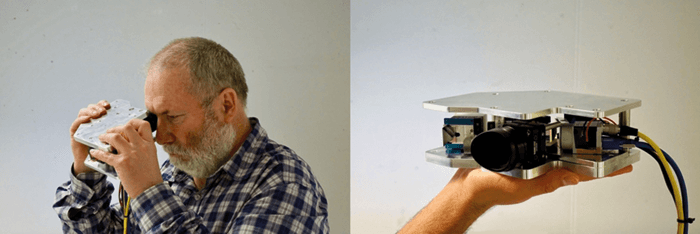
AMD may well be treatable with anti-VEGF injections, but it comes at a cost to the patient: regular visits to the ophthalmologist’s office for disease monitoring with OCT. For elderly and visually impaired patients who require travel assistance, these frequent appointments can represent a further burden on their relatives – or their finances. A team from Universitätsklinikum Schleswig-Holstein, Kiel, and Medical Laser Center, Lübeck, Germany, have a potential solution in the form of a hand-held OCT device for home-monitoring of patients with retinal disease. Given today’s advanced – and costly – OCT systems, what does a home-care setup look like, and how can it be achieved? “For a device to be used by the patients themselves, it needs to be small and low-cost,” explains Claus von der Burchard, Research Fellow at Universitätsklinikum Schleswig-Holstein. “To get there, we’ve had to make some compromises on image quality.” The result is off-axis full-field time-domain OCT (1). Von der Burchard explains: “We focused on reducing the scan area to 3 x 3 mm and using a full-field system which illuminates the whole field.” According to von der Burchard, the 3 x 3 images provide good sensitivity and specificity for monitoring subretinal and intraretinal fluid volume, and the full-field approach increases visual quality. “The design is also very simple, needing only a standard light source – rather than swept-source – and a regular, low-cost USB camera.”

Though the team are still in the research phase, they have tested their device – alongside spectral-domain (SD)-OCT – in 10 patients with retinal disease (including AMD and retinal vein occlusion), and have shown that it can acquire clinically-useful images (Figure 1). “Even though the image quality is not quite as good as clinical OCT systems, the subretinal fluid does demark very well and the need for re-treatment is apparent,” says von der Burchard. The team plans to continue developing their device, and study its imaging capabilities in more patients by asking clinicians to grade both full-field OCT and SD-OCT images (while being masked), and compare their image quality, which biomarkers are present, and whether the patient needs anti-VEGF retreatment. “We believe that a hand-held OCT device would have a huge impact on alleviate disease burden, and may represent a paradigm shift in the treatment of wet AMD and other diseases.”
References
- H Sudkamp et al., “In-vivo retinal imaging with off-axis full-field time-domain optical coherence tomography”, Opt Lett, 41, 4987–4990. PMID: 27805666.
